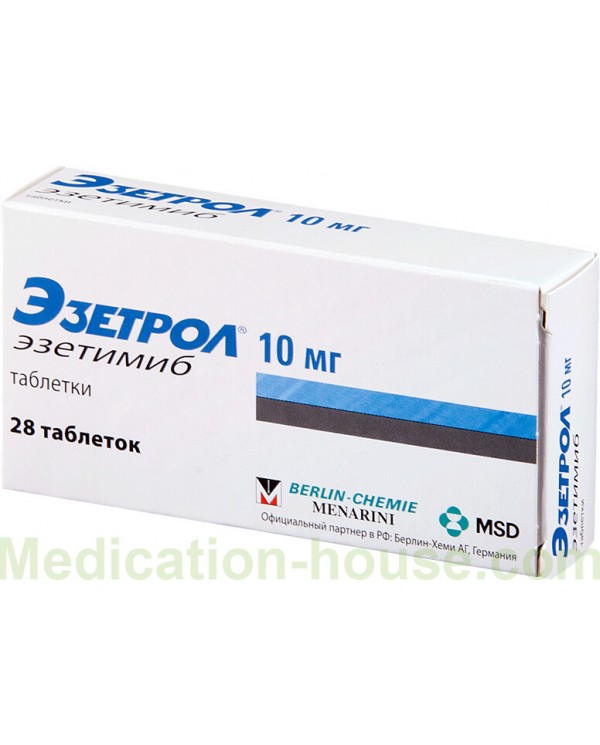Instruction for use of Ezetrol
To buy Ezetrol just add it to your shopping cart
Pharmachologic effect
One tablet of Ezetrol contains 10 mg of the active ingredient - ezetimibe. Used as auxiliary substances: microcrystalline cellulose, sodium lauryl sulfate, povidone, magnesium stearate, croscarmellose sodium, lactose monohydrate.
Ezetrol belongs to the group of lipid-lowering drugs. The drug is intended for oral administration. The mechanism of action of the drug differs from other analogues of Ezetrol from the hypolipidemic class of drugs, such as statins, fibrates and styrenes of plant origin. When it enters the small intestine, the drug concentrates in the brush border of the small intestine and interferes with the absorption of cholesterol, reducing the flow of cholesterol into the liver, due to which its concentration in the liver decreases.
Ezetrol affects the increase in the excretion of bile acids. According to the results of a two-week clinical trial in which 18 patients participated, it was found that taking the drug reduced the absorption of cholesterol by 54%. Thus, the likelihood of developing atherosclerosis is reduced. Studies have established that mortality caused by cardiovascular diseases is in direct proportion to total cholesterol levels; accordingly, its reduction lowers the level of morbidity and mortality.
Pharmacokinetics
After oral administration, Ezetrol is rapidly absorbed in the small intestine and liver, forming the pharmacologically active phenolic glucuronide. The maximum concentration of glucuronide in the blood plasma occurs in 1-2 hours, ezetimibe - in 5-12 hours. Due to the almost complete insolubility of the drug in water, it is impossible to determine its absolute bioavailability.
With a standard single dose of 10 mg, simultaneous intake with food does not affect the bioavailability of Ezetrol. The drug binds to blood proteins by 99.7%
Ezetrol metabolism occurs mainly in the liver and small intestine by conjugation (phase II reaction) with glucuronide. The drug is excreted in the bile.
After ingestion of 20 mg of the drug labeled with 14C-ezetimibe, the level of ezetimibe in the blood plasma was 93% of the radioactivity in the blood plasma. After 48 hours, no radioactive traces were found in the blood plasma. The half-life of Ezetrol is approximately 22 hours. From the total amount of the dose, within 10 days, about 11% is excreted in the urine, about 78% in the feces.
There are no pharmacokinetic data in children under 10 years of age. The indicators of metabolism and absorption of the drug in adults and adolescents from 10 to 18 years old are the same.
Patients with mild hepatic impairment do not need to select an individual dosage. In women, the concentration of the drug in the blood plasma is slightly higher, by about 20%, than in men.
Indications
homozygous sitosterolemia;
primary hypercholesterolemia;
homozygous familial hypercholesterolemia.
Contraindications
Liver failure (moderate to severe);
lactose intolerance;
hypersensitivity to the components of the drug;
age up to 18 years.
Caution should be exercised when prescribing the drug to patients taking cyclosporine. It is not recommended to take analogues of the drug simultaneously with fibrates, until data on the results of clinical trials are obtained.
Dosage
Before starting treatment with the drug, patients should follow a lipid-lowering diet aimed at lowering cholesterol. You can take the drug regardless of food intake.
The dose recommended by the instruction of Ezetrol, both for monotherapy and in combination with statins, is 10 mg per day.
Patients with mild renal or hepatic impairment and elderly patients do not need individual dosage. Ezetrol is not recommended for moderate to severe hepatic impairment.
Overdose
From the reviews received about the overdose with the drug, it was found that in most cases the overdose is not accompanied by undesirable reactions, and when they occur, they are not pronounced and transient.
In case of an overdose with the drug, the instruction recommends supporting and symptomatic therapy.
Interaction of Ezetrol with other drugs
Ezetrol does not affect the pharmacokinetics of oral contraceptives (levonorgestrel and ethinyl estradiol), dapsone, glipizide, midazolam, tolbutamide, dextromethorphan, warfarin and digoxin.
The combination with cimetidine does not affect its bioavailability.
When taken simultaneously with antacids, the absorption rate decreases without affecting its bioavailability.
The combination of taking Ezetrol with gemfibrozil and fenofibrate increases the total concentration of the drug by 1.5-1.7 times.
There is no data on the safety of concomitant use with fibrates, which can increase the excretion of cholesterol, as a result of which gallstone disease may occur. Therefore, the simultaneous administration of Ezetrol analogs and fibrates is not recommended.
There was no clinically significant pharmacokinetic interaction of the drug with rosuvastatin, fluvastatin, lovastatin, pravastatin, simvastatin and atorvastatin.
Pregnancy and lactation
No reviews have been received on the results of the use of Ezetrol by pregnant women, therefore, the use of Ezetrol by the instructions is not recommended during pregnancy. When determining the onset of pregnancy, use of the drug should be discontinued.
There is no data on the elimination of Ezetrol in breast milk, therefore, it is recommended to stop breastfeeding before taking the drug.
Side effects
In clinical trials with a duration of up to 14 weeks, in which 3366 patients took part, the drug was well tolerated with a daily intake of 10 mg in combination with statins or as monotherapy. Mild and rapidly transient side effects were recorded, the frequency of side effects did not differ from the frequency of the placebo group.
With monotherapy, the following side effects are possible: diarrhea, abdominal pain, headache.
When combining Ezetrol and statin, the following may occur: myalgia, nausea, bloating, diarrhea, constipation, abdominal pain, fatigue, headache.
The reviews received on the clinical use of Ezetrol showed the possibility of developing the following reactions: paresthesia, nausea, pancreatitis, skin rash, thrombocytopenia, angioedema, rarely - rhabdomyolysis, myopathy.
Storage conditions
The drug is stored out of the reach of children at room temperature.
Terms of sell
You can buy Ezetrol without a doctor's prescription.

